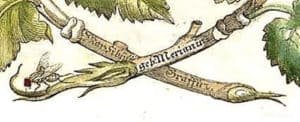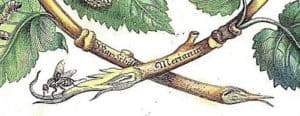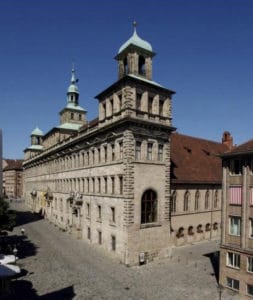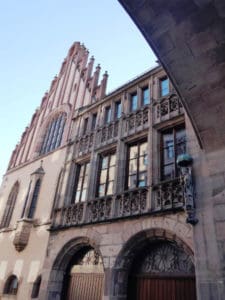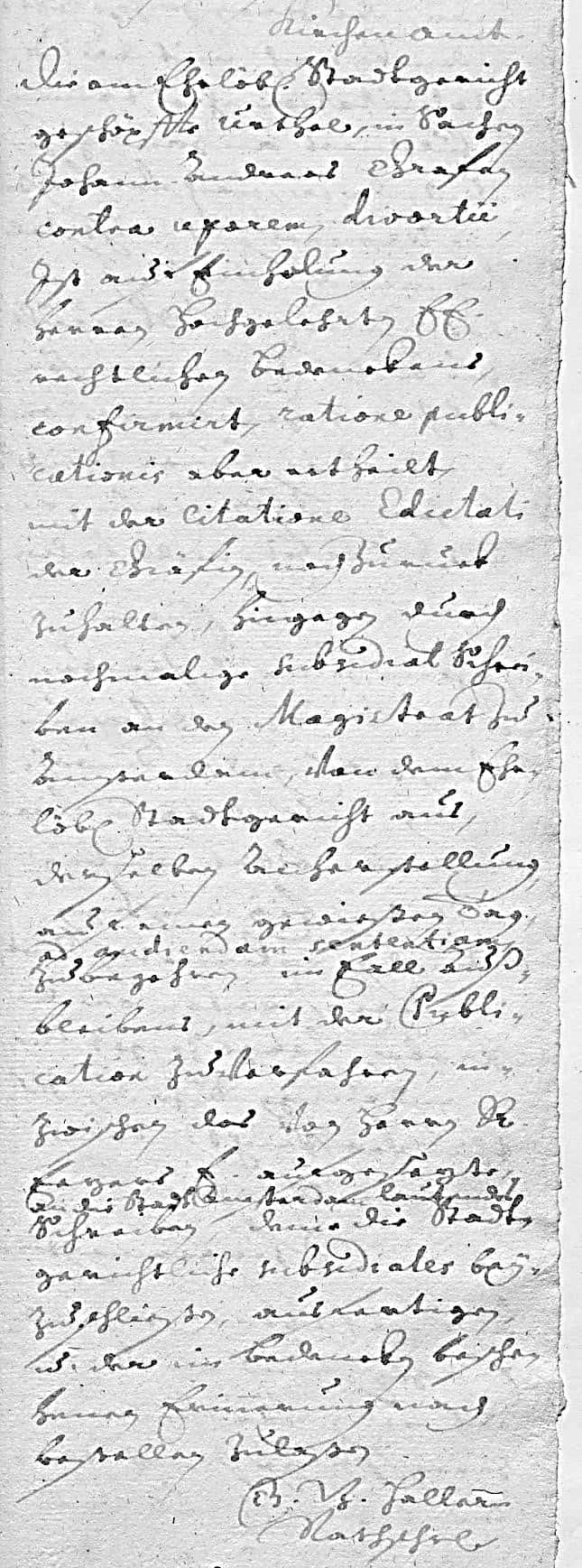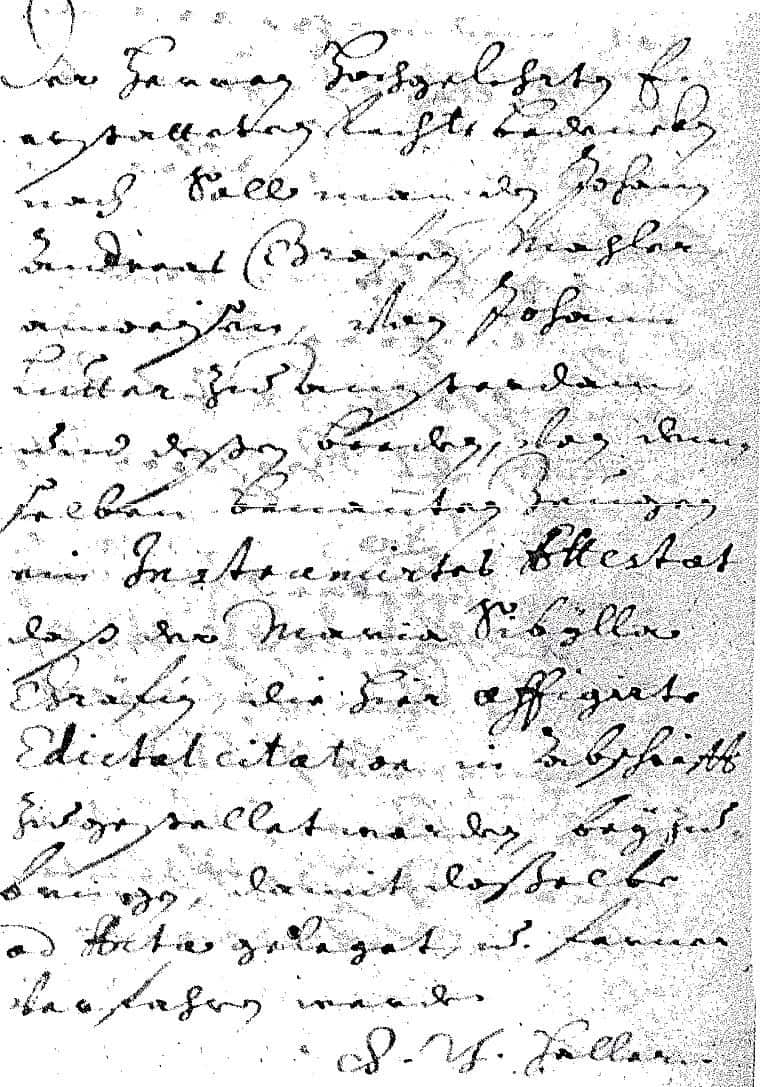END OF THIS MARRIAGE IN COUNCIL DOCUMENTS
Maria Sibylla Merian has definitively drawn a line under her marriage as "Frau Gräffin" at the Waltha Estate in Friesland. Among the Labadists, marriages were only recognised if both spouses if lived on the Estate together. Since Graff was not accepted into the community, the situation was clear for the members of the community: the marriage no longer existed for them.
The title copper print of the First of Caterpillar Book reveals, subtly but clearly, how Maria Sibylla became more and more independent after the breakdown of her marriage. On the lower mulberry branches on the copper plate two words were erased because they recalled the period when she was married: no more "Gräffin" and no more "geb." (née) since she had adopted her maiden name again. Later still her name was shortened to "Merian" (without the "in"), because in Amsterdam female endings on the family name were not usual for women. (1)
A notarial deed of 1699 recording a new will, drawn up before she departed for Surinam, shows how important this independence was for "Mrs Merian". In it she had herself referred to as a "widow", although Johann Andreas Graff was still alive. (2)
West Façade of the Town Hall, built 1616-1622, five Decades before the Graff-Merian Family moved to Nuremberg
Photo: Christine Dierenbach
East façade of the "Old Town Hall", detail showing windows of the Council Chamber, the then political and administrative centre of power in Nuremberg
Photo: Dieter Lölhöffel
However, for a long time Graff could not bring himself to accept the breakdown of his marriage. He sought contact with his wife's legal advisor in Frankfurt (1688). Even the legal advisor of the city of Nuremberg intervened in support of Graff. In 1690, about four years after the deeply religious Labadist community in Waltha had rejected him, Graff wrote an extremely long letter to his wife's legal counsel in Frankfurt. On three densely written pages, which are preserved in Frankfurt University Library, (3) we can still read how desperate he was and how very worried about his younger daughter, who lived with the strict Labadists. However, all his efforts were in vain.
In his case, Nuremberg Council was responsible for all divorce proceedings in the city. At that time there was no higher authority which could enforce binding divorce for both partners in the marriage. Nuremberg was a city state with its own jurisdiction and his wife lived in a "foreign country" (the Netherlands) far away.
Without a legitimate separation from his wife, Graff could not remarry. On the one hand, as an honourable citizen he needed a new wife to run his household; but, on the other hand, divorce was a rare and complicated procedure at that time. In Nuremberg it was continuously controlled by the Council as the highest judicial authority.
It was not until 1692 that Graff tried to find a way out of his difficult situation by submitting a petition for divorce to Nuremberg City Council. This application was granted in a “Ratsverlass” (Council decree) and referred to the competent marriage court. A complicated procedure began, which was continuously monitored by the highest Council body in Nuremberg.
So far, it has been possible to locate a total of seven statements by the city government in the minutes of their meetings. They record the course of the proceedings: (4)
1. Graff’s application for a divorce was accepted (18 August 1692)
2. Expert reports by two legal consultants, the official legal advisers to the City Council, were commissioned and later discussed in the committee of the “Senior Gentlemen” (19 January 1694)
3.-5. Contact was made with Amsterdam three times, in order to inform Mrs Graff about the proceedings and to request her response (20 February, 1 and 31 March 1694). However, this did not materialize.
6. When the extended deadline passed without a response, the legal advisers were consulted again (11 April 1694)
erneut befragt (11.04.1694)
7. Only then was the decree granting divorce officially “published” in Nuremberg and Amsterdam (30 May1694).
Legal opinion at the time was completely on Graff’s side and against his “wife, who had eloped to the Labadists”. Nevertheless, in this case, too, the Council wanted to follow its own maxim and hear both sides, even if the other side was (only) a woman. Through its good connections in Amsterdam, the Council tried to contact "Mrs Graff": But she did not reply. Therefore, the proceedings stretched out even longer and it took more than 21 months for the divorce to become final in the following wording: “According to the report submitted by learned expert counsellors, the decree granted in the case of Johann Andreas Graff vs his disloyal wife by the most honourable city and marriage court shall be published.”
On 10 June 1694 the banns for Graff’s new marriage were publicly announced and two weeks later he could finally get married again. His second wife, Anna Maria (1666-1711), was thirty years his junior. As the daughter of the colourist Hoffmann, (5) she may even have collaborated on some of his “old-coloured” etchings, which were produced by Kraus in Augsburg after Graff’s drawings and taken to Nuremberg to be illuminated.
IN THE HISTORIC COUNCIL MINUTES
Council decree 2936, fols. 2r+2v
Graff’s application for his divorce and its referral to the competent municipal court
Graff's application is accepted, i.e., he may apply to the competent court for a divorce.
Johann Andreas Graffen, Mahlern,
[Fortsetzung 2v]
welcher ansuchet, daß er von seinen nun
über 7. Jahr von ihm zu denen Labadisten
entwichenen Weib, absque strepitu iudicii *)
totaliter möchte geschieden werden, soll
man mit solchem Begehren ab- und ihn zu
ordentlicher Ausführung an das Ehrlöb[liche]
Stattgericht verweißen.
Burgerm[meister]: Jun[ior]:
*) ohne den Lärm des Urteils = ohne öffentliches Verfahren
Council decree 2954, fol. 101v
Two assessments on the divorce case are requested by two city consultants.
Two official legal experts are commissioned by the council to give advice regarding the judgement on the divorce by the city court; their response is awaited before a decision is made on the publication (pronouncement) of the decision.
Die am Ehrlöb[lichen]. Stadtgericht
geschöpfte Urthel in Sachen
Johann Andreas Grafen
contra uxorem divortii,
Soll man samt denen
übrigen Actis für Herren
DDr. *) Fezers und Silber=
radts E E. auch, da es nö=
thig noch für einen andern
außer dem Stadtgericht
bringen, zu überlegen, ob
solche zu publicirn seyn
möge.
G. B. Haller
*) Doctores = Dr. Fezer + Dr. Silberradt.
Council decree 2955, fol. 105r
A letter to Amsterdam contains efforts to obtain a statement from the wife.
Maria Sibylla is to be given the opportunity to respond in the case of the pending decision on the divorce by the city court.
Die am Ehrlöb[lichen]. Stadtgericht
geschöpffte Urthel in Sachen
Johann Andreas Grafen
contra uxorem divortii,
ist auf Einholung der
Herren Hochgelehrten EE,
rechtlichen Bedenckens
confirmirt, ratione publi=
cationis aber ertheilt,
mit der Citatione Edictali
der Gräfin, noch zurück
zuhalten, hingegen durch
nochmalige Subsidial Schrei=
ben an den Magistrat zu
Amsterdam, von dem Ehr=
löb[lichen]. Stadtgericht aus,
derselben Anherstellung
auf einen gewiesten Tag,
ad audiendam sententiam
zu begehren, im Fall Auß=
bleibens, mit der Publi=
cation zu verfahren, in=
zwischen das von Herrn Dr.
Fezers E. aufgesezte,
an die Stadt Amsterdam lautendes [sic!]
Schreiben, deme die Stadt=
gerichtliche subsidiales bey
zuschließen, ausfertigen,
u[nd]. der im Bedencken besche=
henen Erinerung nach
bestellen zulaßen.
G. B. Haller .
Rathschr[eiber]
Council decree 2956, fol. 37r
Continued waiting for a statement from "Mrs. Graff"
With respect to the divorce decree, a reaction from Amsterdam was still to be awaited, but at the same time preparations are to be made for further steps in the proceedings.
Weiln die Citatio Edicta=
lis, in sachen Joh: Andreae
Grafens 9*) uxorem, Ma=
ria Sibylla Gräfin, in
p[unct]õ divortii, dem Verneh=
men nach, albereit gehö=
riger orten angeschlagen
worden = und ihro abschrifft=
lich zu Handen kom[m]en seyn
solle; Als ist verlaßen,
mit abschickung deß an
den Löb[lichen]. Magistrat zu
Ambsterdam destinirt[en]
Subsidial-schreibens noch
in etwas zurückzuhalt[en],
die bey den Actis befind=
liche Schreiben aber an
das E[hrlöblichen]. Stadt= und Ehege=
richt zu geben, und das=
selbe anzuweisen, wann
die Gräfin nicht erscheinen
oder sonsten die nothdurfft
zuverfügen ermangeln
würde, es hinwied[er]umb
zuberichten, wie Herrn
Dr. Fetzers und H[errn]. Dr. Sil=
berrads E. E. an Hand
gegeben.
G. B. Haller:
*) Kürzel für „contra“ = gegen
Council decree 2957, fol. 51r
Further hearing of the council consultants despite the wife's lack of response
Since Graff's wife has not responded to three "summonses", Graff's request for the disclosure of the divorce decree is to be considered.
Über des Herrn Richters,
Assessorum und Schöpffen
am Ehrlöb[lichen] Stadtgericht
übergebenen Bericht, dz.*)
des Johann Andreas Gra=
fens Eheweib auf drey=
malige citation nicht er=
schienen, daher derselbe
nun Eröffnung der Ur=
thel in contumacione wie=
der sie bitte, soll man
der Herren Hochgelehrten
EE. die in dieser Sache ge=
höret worden, beyräthige
Mainung vernehmen,
ob hierinnen zu willfahrn
seye. G. B. Haller
*) „dz“ = Kürzel für dass
Council decree 2958, fol. 7r
A decision is made on the serving of the divorce decree to Graff and to Amsterdam.
The divorce decree of the city court is to be delivered to Johann Andreas Graff. Mrs. Graff (= Maria Sibylla Merian) has also to be informed of the decision via Johann Lutter as intermediary in Amsterdam and two witnesses appointed there.
Der Herren Hochgelehrten E.
erstatteten Rechts Bedencken
nach, soll man den Johann
Andreas Grafen, Mahler,
anweisen, von Johann
Lutter zu Amsterdam,
und deßen beeden, von dem=
selben benannten Zeugen
ein Instrumentirtes Attestat
daß der Maria Sibylla
Gräfin die hier affigirte
Edictal citation in Abschrifft
zugestellet worden, beyzu=
bringen, damit daßelbe
ad Acta geleget, u. ferner
verfahren werde.
G. B. Haller.
Council decree 2859, fol. 87r
Decision on the publication of the divorce decree
"Johann Andreas Graff's marriage was legally divorced in 1694. Since the beginning of that year, several decrees of the council were issued in this case, the last one on 30.5.1694. A few days later, Johann Andreas Graff married a second time."
(Quote from Friedrich von Hagen; see source below)
Der Herren Hochgelehrten EE. aus=
gestellten Gutachten gemäß
soll man mit Publicirung
des in Johann Andreas
Grafen wider sein trün=
niges weib am Ehrlöb[lichen]. Stadt u[nd].
Ehegericht ergangenen
urthels verfahren, zu=
vor aber die im beden=
cken ernante beede Schreiben
wie anhand gegeben re=
cognosciren laßen.
G. B. Haller.
Source of transcription of all seven council decrees listed here: Friedrich von Hagen, StadtAN E10/133 NL 49, "Gra" (not published), revised by Gunter Friedrich, Karl Kohn and Margot Lölhöffel
cf. also Hagen, Friedrich von, Genealogien und Viten des 16., 17. und 18. Jahrhunderts, in: Tacke, Andreas (eds.), Der Mahler Ordnung und Gebräuch in Nürnberg, Die Nürnberger Mahler(zunft)bücher supplemented by additional sources, München - Berlin 2001, p. 420f, ISBN 3-42206343-9



